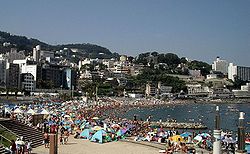Atami
Atami
熱海市 | |
|---|---|
 Beach in Atami City with sea bathers | |
 Location of Atami in Shizuoka Prefecture | |
| Country | Japan |
| Region | Chūbu (Tōkai) |
| Prefecture | Shizuoka Prefecture |
| Government | |
| • - Mayor | Sakae Saitō |
| Area | |
| • Total | 61.61 km2 (23.79 sq mi) |
| Population (June 2012) | |
| • Total | 38,879 |
| • Density | 631/km2 (1,630/sq mi) |
| Time zone | UTC+9 (Japan Standard Time) |
| - Tree | Sakura |
| - Flower | Ume |
| - Bird | Common Gull |
| Phone number | 0557-86-6000 |
| Address | 1-1 Chūō-chō, Atami-shi, Shizuoka-ken 413-8550 |
| Website | www |

Atami (熱海市, Atami-shi) is a city located in the eastern end of Shizuoka Prefecture, Japan.
As of June 2012, the city had an estimated population of 38,871 and a population density of 631 people per km². The total area is 61.61 km2 (23.79 square miles).
Geography
Atami is located in the far eastern corner of Shizuoka Prefecture at the northern end of Izu Peninsula. The city is on the steep slopes of a partially submerged volcanic caldera on the edge of Sagami Bay. The name "Atami" literally means "hot ocean," a reference to the town's famous onsen hot springs. The city boundaries include the offshore island of Hatsushima. Most of Atami is located within the Fuji-Hakone-Izu National Park. Warmed by the Kuroshio Current offshore, the area is known for its moderate maritime climate with hot, humid summers, and short winters.
Surrounding municipalities
Shizuoka Prefecture
Kanagawa Prefecture
History
Atami has been known as a resort town centered on its hot springs since the 8th century AD. In the Kamakura period, Minamoto Yoritomo and Hōjō Masako were notable visitors. During the Edo period, all of Izu Province was tenryō territory under direct control of the Tokugawa shogunate. During the cadastral reform of the early Meiji period in 1889, Atami village was organized within Kamo District, Shizuoka. It was elevated to town status on June 11, 1894, and was transferred to the administrative control of Tagata District, Shizuoka in 1896.
The epicenter of the Great Kantō earthquake in 1923 was deep beneath Izu Ōshima Island in Sagami Bay, close to Atami, which suffered considerable damage, as did other municipalities throughout the surrounding Kantō region.[1] The tsunami wave height reached 35 feet at Atami, swamping the town and drowning three hundred people.[2]

The modern city of Atami was founded on April 10, 1937, through the merger of Atami Town with neighboring Taga Village. After the proclamation of Atami as an "International Tourism and Culture City" by the Japanese government in 1950, the area experienced rapid growth in large resort hotel development. This growth increased after Atami station became a stop on the Tōkaidō Shinkansen high-speed train line in 1964. In concert with its famous onsen, Atami was known for its onsen geisha. Atami experienced a considerable decline in popularity as a vacation destination due to the Japanese economic crisis in the 1990s and the associated fall in large group company-sponsored vacations, but is currently experiencing a revival as a bedroom community due to its proximity to Tokyo and Yokohama.
The Inagawa-kai, third largest of Japan's Yakuza groups, was founded in Atami in 1949 as the Inagawa-gumi (稲川組) by Kakuji Inagawa.[3]
The 24th Congress of the Japanese Communist Party was held at Atami in January 2006.
Economy
The economy of Atami is heavily dependent on the tourist industry, mostly centered around its hot spring resorts.[4] Commercial fishing is a major secondary industry.
Transport
Rail
Highways
- National Route 135
- Atami Beach Line
- Izu Skyline
International relations
Twin towns – Sister cities
Atami is twinned with:
 Beppu, Ōita, Japan (since August 1966)
Beppu, Ōita, Japan (since August 1966) Sanremo, Italy (since November 1976)
Sanremo, Italy (since November 1976) Cascais, Portugal (since July 1990)
Cascais, Portugal (since July 1990) Acapulco, Mexico
Acapulco, Mexico
Notable people from Atami
- Yu Hayami—singer, actress
- Yuka Imai—voice actress
- Yuji Ohno—jazz musician
- Mitsuko Uchida—classical pianist
Culture
Much of the extensive art collection of eccentric multimillionaire and religious leader Mokichi Okada is now housed in the MOA Museum of Art in Atami.
Atami is also notable for having a Peace Pagoda, built by Nipponzan-Myohoji Daisangha in 1961.
In films
In the 1953 film Tokyo Story, the parents visit the hot springs in Atami. Atami is the setting of the TV drama Atami no Sousakan. It also appears in the 1954 film "Golden Demon" (Konjiki Yasha), based on the novel of the same name by Koyo Ozaki, as the place where two main characters become engaged to be married.[5]
Notes
- ^ Hammer, Joshua. (2006). Yokohama Burning: the Deadly 1923 Earthquake and Fire that Helped Forge the Path to World War II, p. 278.
- ^ Hammer, p. 114.
- ^ "1993 Police White Paper Chapter 1 : The Actual Condition of the Boryokudan", 1993, National Police Agency Template:Ja icon
- ^ Mansfield, Stephen, "Cultures mingle amid Atami's hot springs", Japan Times, 18 December 2011, p. 12.
- ^ '+relative_time(twitters[i].created_at)+' (2010-04-18). "Odagiri to star in "Atami no Sousakan"". Tokyograph. Retrieved 2013-03-25.
{{cite web}}:|author=has generic name (help)
References
- Hammer, Joshua. (2006). Yokohama Burning: The Deadly 1923 Earthquake and Fire that Helped Forge the Path to World War II. New York: Simon & Schuster. ISBN 0-7432-6465-7; ISBN 978-0-7432-6465-5 (cloth).
External links
- Atami City official website Template:Ja icon
 Atami travel guide from Wikivoyage
Atami travel guide from Wikivoyage


